Normal Socket After Tooth Extraction: Healing Stages and Care Guide
Why Most People Worry About Their Tooth Extraction Site
Americans get about 5 million wisdom teeth pulled every year. That's jus wisdom tetch, pretty big number, right? You might just had a tooth pulled and now you're asking yourself if that weird looking hole in your mouth is normal or not. Lots of people worry about this, but it's actually pretty normal.
How Your Body Naturally Heals an Extraction Socket
Your body starts fixing that empty socket right away. The bleeding stops, new tissue grows in, and eventually bone fills the space. Many patients feel confused about what looks normal during this process. A recent study found that nearly 7 out of 10 patients worry about normal healing signs because they don't know what to expect.
What to Expect During Different Healing Stages
That hole where your tooth used to be goes through many changes as it heals. It starts as a raw spot with a blood clot and transforms into healthy gum tissue over time. Knowing what happens during each stage helps you spot actual problems that need a dentist's attention. It is important to note that lower back teeth can take much longer to heal fully than front teeth.
More than 5 million extractions lead to dental implants each year, showing how common and routine these procedures have become. But even routine procedures need proper aftercare to make sure everything heals right.
What Is a Tooth Socket?
How the Tooth Socket Forms in Your Jawbone
A tooth socket refers to the cavity or hole in your jawbone where your tooth sits. Each tooth has its own custom fit socket held in place by periodontal ligaments. When a dentist removes a tooth, the empty space left behind is what we call the extraction socket.
What the Inside of a Tooth Socket Contains
The socket contains bone on all sides and is lined with periodontal tissue. Blood vessels run through this area, which explains why extraction sites bleed initially. These blood vessels play a critical role in forming a protective clot and delivering healing components to the area.
Why Different Teeth Have Different Socket Sizes
The size and depth of the socket depend on which tooth was removed. Molar sockets tend to be larger and deeper than those of front teeth. The shape also varies based on the tooth's root structure. Teeth with multiple roots create more complex sockets than single rooted teeth.
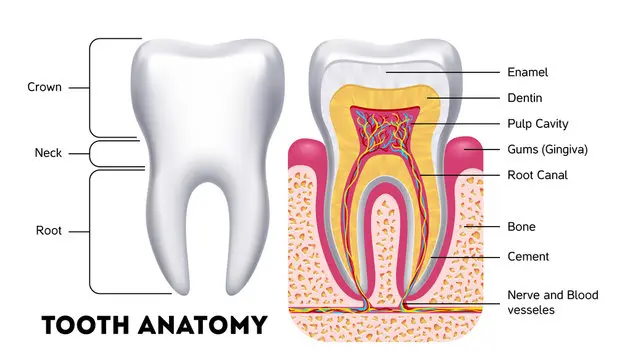
Detailed view of a tooth socket showing surrounding bone structure
Healing Timeline After Extraction
What Happens in the First 24 Hours After Tooth Extraction
Healing happens in stages, each with distinct characteristics. Timing can vary between individuals based on age, overall health, and the complexity of the extraction.
During the initial 24 hours, bleeding gradually stops as a blood clot forms in the socket. This clot acts as a protective covering, like a bandage. It appears dark red or purple and fills the entire socket. You might notice slight oozing during this period, which typically resolves with gentle pressure from a gauze pad given to you by your dentist.
How Your Extraction Site Changes During Days 2-3
Days 2-3 bring mild swelling around the extraction area, which peaks around the third day before gradually subsiding. The clot begins to stabilize and appears darker. The edges of your gums might look slightly puffy or red. Discomfort typically decreases during this period as inflammation resolves.
What the White Tissue in Your Socket Means (Days 4-7)
Between days 4-7, the body starts forming granulation tissue over the clot. This tissue might appear whitish gray or cream colored and can be mistaken for infection by some patients. However, this tissue represents the initial healing layer covering the socket and is completely normal. The swelling should noticeably decrease during this time.
How New Gum Tissue Forms in Your Socket (Days 7-10)
Around the 7-10 day mark, pink tissue becomes visible as new gum tissue begins growing over the socket. The distinct "hole" appearance starts to fade as the socket fills from the bottom up. Pain typically subsides significantly by this point, though the area may feel slightly different from surrounding tissue when touched with your tongue.
What Changes to Expect During Weeks 2-4 After Extraction
Weeks 2-4 show continued filling of the socket with soft tissue. The sharp edges of bone around the socket start to smooth out. The pink tissue covering the socket gradually blends with surrounding gum tissue, though it might appear slightly lighter in color.
How Bone Fills Your Extraction Socket (1-3 Months)
Between 1-3 months, new bone cells begin filling the socket from the bottom and sides. The socket becomes increasingly shallow as bone fills in. Surface tissue strengthens and becomes more resilient. You might still feel a slight indentation when running your tongue over the area.
When Your Extraction Site Is Fully Healed (3-6 Months)
Complete healing with full bone regeneration typically takes 3-6 months. The socket area becomes level with surrounding bone, though a small indentation might remain, especially with larger teeth. The gum tissue fully matures and matches surrounding tissue in both color and texture.
Research published in the Journal of Oral and Maxillofacial Surgery indicates that bone density in extraction sites reaches approximately 75% of the original pre-extraction density after six months, demonstrating how effectively the body rebuilds this area.
Signs of Normal Healing vs. Complications
How to Tell If Your Extraction Site Is Healing Normally
Normal healing has several signs that indicate everything is progressing as expected. The blood clot stays in place throughout healing, gradually being replaced by granulation tissue. You may experience mild pain that diminishes each day. Minimal swelling occurs initially but decreases after day three. The extraction site gradually changes from a defined socket to a smooth surface over weeks. Your breath returns to normal after the initial few days.
Warning Signs That Your Extraction Site Isn't Healing Properly
Complications, though uncommon, require quick attention. Persistent severe pain, especially if it increases after a few days, signals a problem. Excessive bleeding beyond 24 hours needs to be checked by your dentist. Severe swelling that worsens after day three or extends beyond the extraction area may indicate infection. Pus discharge, foul odor or taste, or fever above 100.4°F (38°C) suggests you might have an infection and should see your dentist.
How to Identify Dry Socket After Tooth Extraction
One of the most common complications is dry socket (alveolar osteitis), which occurs in approximately 3-5% of all extractions. This can happens when the protective blood clot dislodges or dissolves too early, exposing nerve endings and bone. Symptoms typically appear 3-5 days after extraction and include intense pain that radiates to the ear, temple, or neck.
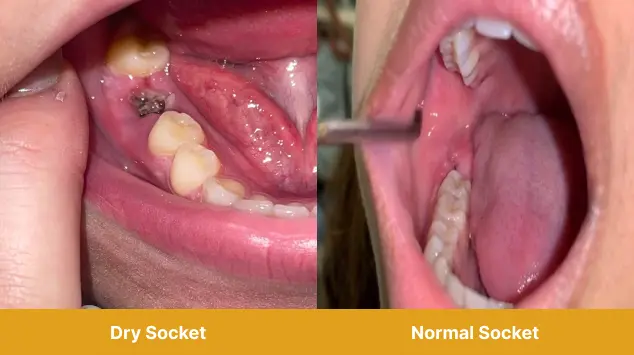
Visual comparison between normal healing socket (left) and dry socket (right)
What Infection in an Extraction Site Looks Like
Another potential issue involves infection, which might present as increased pain, swelling, and drainage several days after extraction. Research from the Mayo Clinic shows that proper aftercare reduces infection risk significantly, highlighting the importance of following post-extraction instructions.
What affects socket healing?
How Your Age Affects Extraction Site Healing Time
Several factors influence how quickly and effectively your extraction socket heals. Age plays a significant role as younger patients typically heal faster due to better blood circulation and cell regeneration capabilities. General health conditions impact healing too. Diabetes, autoimmune disorders, and cardiovascular disease can slow the healing process by affecting blood flow and immune response.
Why Surgical Extractions Take Longer to Heal
Surgical extractions with bone removal generally take longer to heal than simple extractions. The tooth's location also affects healing time as molars with multiple roots create larger sockets that take longer to fill compared to single rooted front teeth.
How Smoking Delays Socket Healing After Extraction
Smoking dramatically impairs healing by restricting blood flow to tissues and introducing toxins to the healing site. Research published in the Journal of the American Dental Association demonstrates that smokers experience significantly higher rates of complications and delayed healing compared to non-smokers.
Best Foods to Eat for Faster Socket Healing
Nutrition plays a vital role in wound healing. Protein, vitamin C, zinc, and other nutrients provide the building blocks necessary for tissue repair. Patients with poor nutritional habits may experience slower healing. Medications such as blood thinners, some osteoporosis medications, and immunosuppressants can affect how quickly and effectively the socket heals.
How Oral Hygiene Affects Extraction Site Recovery
Oral hygiene practices during recovery significantly impact healing outcomes. Careful cleaning around the site without disturbing the clot helps prevent infection and supports normal healing progression.
Proper Care for Extraction Sockets
What to Do During the First 24 Hours After Extraction
Caring for your extraction socket properly speeds up healing and reduces complication risks. During the initial 24 hours, leave the gauze pad in place for 30-45 minutes after extraction to allow clot formation. Avoid rinsing, spitting, or drinking through straws, as these actions create suction that could dislodge the clot. Apply ice packs externally for 10 minute intervals to minimize swelling.
How to Clean Your Mouth After Tooth Extraction
From day two onward, gently rinse with warm salt water (half teaspoon salt in 8 ounces warm water) 3-4 times daily, especially after meals. Continue normal brushing and flossing, but avoid the extraction site for the initial 24 hours. Gradually clean closer to the site as healing progresses, but avoid disturbing the clot.

Proper aftercare includes gentle salt water rinses to keep the area clean
What Foods Are Safe to Eat After Tooth Extraction
Regarding diet, choose soft, lukewarm foods for the initial 48 hours. Good options include yogurt, applesauce, mashed potatoes, and smoothies consumed with a spoon rather than through a straw. Avoid extremely hot foods or beverages that could dissolve the clot. Stay away from crunchy, spicy, or acidic foods that might irritate the site or become lodged in the socket. Stay hydrated but avoid alcohol consumption, which can interfere with blood clotting and healing.
How to Manage Activity and Rest After Extraction
Rest on the day of extraction, avoiding strenuous exercise for at least 48-72 hours. Physical exertion increases blood pressure, which may lead to increased bleeding. Sleep with your head slightly elevated using extra pillows to reduce swelling and throbbing sensations. Avoid bending over or lifting heavy objects during the initial healing period.
Best Ways to Manage Pain After Tooth Extraction
When it comes to pain management, take prescribed or recommended pain medications as directed by your dentist. Over the counter options like ibuprofen help reduce both pain and inflammation. Apply ice externally during the initial 24 hours, switching to warm compresses after day three if you experience jaw stiffness.
When to see your dentist?
Warning Signs That Require Immediate Dental Attention
Excessive bleeding that continues beyond 24 hours despite applying pressure with gauze might need to be checked. Severe pain that persists or worsens after 3-4 days, especially if accompanied by throbbing or radiating pain, may indicate dry socket or infection.
When Swelling After Extraction Is a Serious Concern
Significant swelling that increases after day three or extends beyond the extraction area into the neck or eye region needs immediate attention. Difficulty swallowing or breathing is an emergency situation requiring immediate care. Fever above 100.4°F (38°C) suggests infection that needs treatment. Numbness or tingling in the lip, chin, or tongue persisting beyond the expected anesthetic duration requires to be checked, as does any unusual drainage, pus, or foul odor from the extraction site.
What to Do If You Feel Bone Fragments in Your Extraction Site
The presence of sharp bone fragments emerging from the gum tissue (bone spicules) may require removal by your dentist. These small fragments occasionally work themselves out during healing but can cause discomfort if they remain. Bleeding that resumes days after extraction suggests disruption to the healing site and needs evaluation.
If you experience any of these symptoms, please contact your dentist immediately.
Different types of extractions
How Wisdom Tooth Extraction Healing Differs from Other Teeth
Different types of extractions have unique healing considerations. Wisdom tooth extractions often involve larger sockets and sometimes require bone removal, resulting in more swelling and longer healing times. These extractions frequently affect younger patients whose faster metabolism supports quicker healing, though the complexity of the procedure may extend recovery.
Why Surgical Extractions Need Special Aftercare
Surgical extractions involving flaps and bone removal create more trauma to surrounding tissues, leading to increased swelling and longer healing periods. The incision sites need special attention during cleaning. Multiple adjacent extractions affect a larger area of the jaw and may cause more significant changes in appearance during healing. The broader affected area requires more careful cleaning.
How Infection Affects Healing After Emergency Extractions
Emergency extractions due to infection might have delayed initial healing until antibiotics reduce the infection. Prior infection can affect how quickly new healthy tissue forms at the site. Extractions for dental implants often involve specialized techniques to preserve bone. These sites may receive bone grafting materials to maintain socket dimensions for future implant placement.
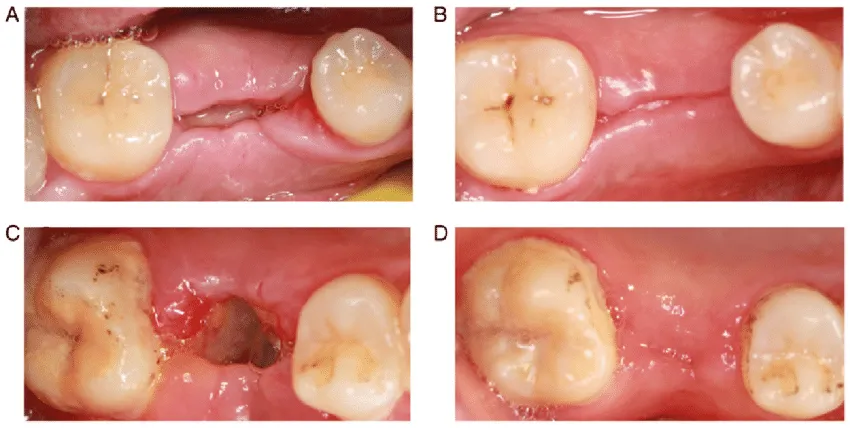
Wisdom tooth extraction sites typically have larger sockets and longer healing times
Long term Changes After Tooth Extraction
How Bone Loss Occurs After Tooth Extraction
The jawbone undergoes natural remodeling after extraction. Without the stimulation from tooth roots, the bone gradually resorbs, with most changes occurring within the initial six months. This process can lead to a narrower and shorter jawbone in the extraction area.
Why Adjacent Teeth Shift After an Extraction
Teeth adjacent to the extraction site may gradually shift position due to the gap. This movement can affect your bite alignment and potentially create spaces between other teeth. The opposing tooth (the one that used to contact the extracted tooth) may gradually erupt or extend further from the gumline without the opposing contact from the tooth that was removed.
How Extractions Can Change Your Facial Appearance
Facial changes might become noticeable with multiple extractions or when front teeth are removed. The lips and cheeks may appear slightly sunken without the support previously provided by the teeth and surrounding bone. Speaking and chewing patterns often adapt naturally over time as you adjust to the missing tooth. You might temporarily notice minor changes in pronunciation, especially if front teeth were extracted.
Tooth Replacement Options
Why Dental Implants Are the Best Option After Extraction
Several options exist for replacing extracted teeth once healing completes. Dental implants provide the most natural looking and functioning replacement. These titanium posts surgically placed in the jawbone support crowns that look and function like natural teeth. Implants also stimulate bone, preventing the resorption that typically follows extraction.
How Dental Bridges Replace Missing Teeth After Extraction
Fixed bridges offer another solution, using adjacent teeth as anchors to support an artificial tooth. This option works well when surrounding teeth would benefit from crowns. Removable partial dentures represent a non surgical, more affordable option that can replace multiple missing teeth. They clip onto remaining teeth and can be removed for cleaning.
When to Plan for Tooth Replacement After Extraction
If you're considering replacement options, plan ahead with your dentist what would be the best option for you. Implants typically require 3-6 months of healing before placement unless using immediate implant protocols. Earlier planning allows for techniques that preserve bone during extraction, creating better conditions for future implants. Cosmetic dentistry approaches can address aesthetic concerns about gaps, especially for visible front teeth.
Preventing Future Extractions
Best Oral Hygiene Practices to Prevent Tooth Loss
Maintaining good oral hygiene forms the foundation of prevention. Brush twice daily with fluoride toothpaste and clean between teeth daily with floss or interdental brushes. Regular professional cleanings and check ups allow early detection of problems before they require extraction. The American Dental Association recommends examinations every six months for most patients.
Why Early Cavity Treatment Prevents Extractions
Addressing dental issues quickly stops small problems from escalating to major issues. Treat cavities early before they reach the tooth's nerve and cause infections requiring extraction. Manage gum disease through proper home care and professional treatments to prevent bone loss that leads to loose teeth. Protect your teeth from trauma by wearing mouthguards during sports activities and night guards if you grind your teeth during sleep.
How Diet Affects Your Long-term Dental Health
A balanced diet supports dental health. Limit sugary foods and drinks that contribute to decay. Consume calcium rich foods to support bone and tooth strength. Avoid habits that damage teeth, such as chewing ice, biting fingernails, or using teeth as tools to open packages.
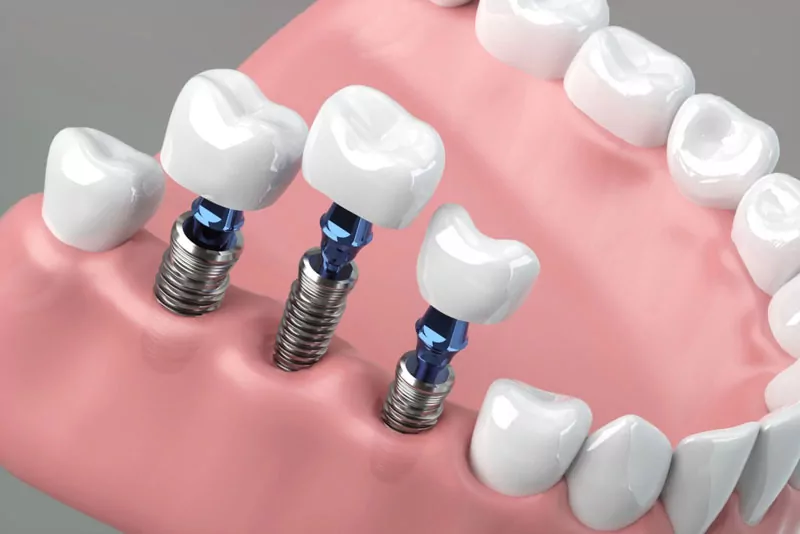
Dental implants provide a permanent solution after extraction site healing
Recovery Tips From Dentist
How to Prepare Your Home Before a Tooth Extraction
Prepare your home before the extraction with soft foods, gauze pads, ice packs, and prescribed medications ready. This preparation allows you to rest immediately after the procedure without worrying about supplies.
Why Following Post-Extraction Instructions Is Critical
Follow all post operative instructions exactly as provided. These guidelines are customized based on your specific extraction and health history. Time your pain medication on time as prescribed.
How Sleeping Position Affects Extraction Site Healing
Keep your head elevated during rest for the initial 48-72 hours to reduce swelling and throbbing sensations. Maintain nutritional intake despite dietary restrictions. Smoothies with protein, cooked vegetables, and soft fruits provide necessary nutrients for healing.
How to Track Your Recovery Progress
Track your recovery progress by making mental notes of how each day compares to the previous one. Gradual improvement should occur daily after the initial 2-3 days. Maintain overall health practices during recovery, stay hydrated, get adequate rest, and avoid alcohol and tobacco products.
Recent Advances in Extraction Techniques
How PRF Therapy Speeds Up Socket Healing
Modern dentistry has developed techniques that promote faster, more comfortable healing. Platelet-rich fibrin (PRF) techniques involve drawing a small blood sample from the patient, processing it to concentrate healing components, and placing this material in the socket. Studies published in the International Journal of Dentistry show this approach accelerates healing and reduces complications.
How Socket Preservation Prevents Bone Loss After Extraction
Socket preservation procedures maintain bone volume after extraction using bone grafting materials placed immediately after tooth removal. This technique proves particularly valuable when planning future implant placement. Advanced suturing techniques create better tissue closure over extraction sites, protecting the blood clot and facilitating more predictable healing.
How 3D Imaging Improves Extraction Procedures
Computer guided extractions utilize 3D imaging to plan the procedure, allowing dentists to visualize root anatomy and surrounding structures before beginning. This technology reduces trauma to adjacent tissues. Instruments like physics forceps apply controlled, gentle forces that preserve bone walls during tooth removal.
The Emotional Side
How to Cope with Anxiety About Tooth Extraction
Tooth extraction can trigger unexpected emotional responses. Many people report feeling a sense of loss or aging after having teeth removed, particularly when visible teeth are involved. These feelings are entirely normal and valid. The change in appearance, even temporarily, might affect self confidence in social or professional settings.
Managing Dental Anxiety During Socket Healing
Anxiety about the healing process or potential pain represents a common concern. Clear information about what to expect helps manage this anxiety. Open communication with your dental provider about both physical and emotional concerns supports overall wellbeing during recovery.
Why Many Patients Find Recovery Easier Than Expected
Many patients report that the recovery proved easier than anticipated, especially when following care instructions diligently. Focusing on the health benefits of removing problematic teeth helps maintain perspective during the temporary discomfort of healing.
Additional Recovery Support
Best Products to Help With Extraction Site Healing
Several products can enhance comfort during recovery. Specialized mouth rinses prescribed by your dentist help control bacteria without disturbing the clot. Cold packs designed specifically for facial use conform better to jaw contours for more effective swelling control. Dental wax can cover any rough edges around the extraction site that might irritate your tongue or cheek.
When You Might Need Prescription Pain Relief
Prescription strength pain relievers (like Tylenol 3) may be necessary for more complex extractions, though many patients manage well with over the counter options. Antibiotics might be prescribed preventatively for certain patients or if infection risk appears elevated.
Why Most Socket Healing Progresses Without Problems
Recovery typically progresses smoothly for most patients when following proper care guidelines. The body has remarkable healing capabilities, especially in the oral cavity where blood supply remains abundant and cell turnover occurs rapidly.
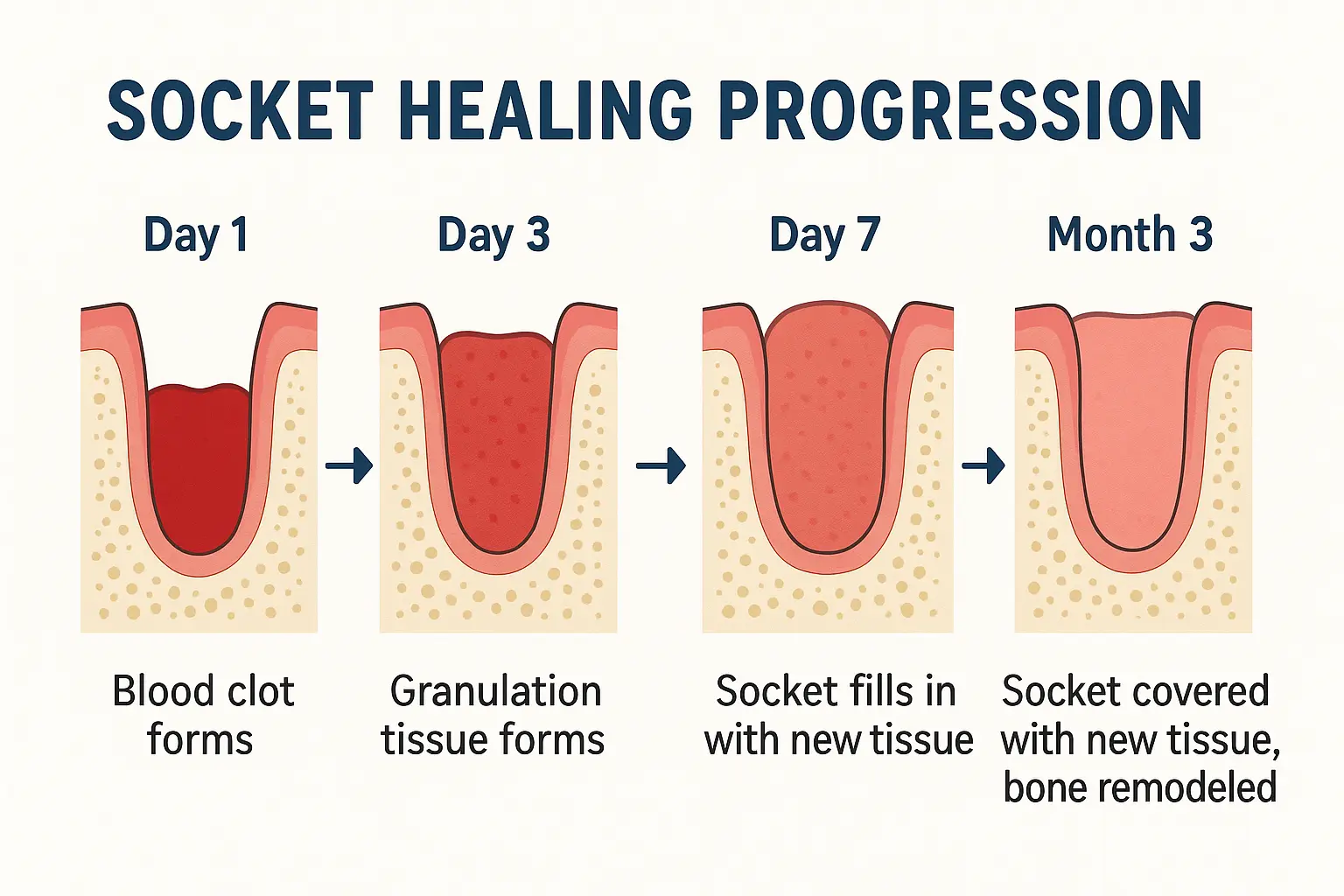
Typical healing progression of an extraction socket over three months
What Your Extracted Tooth Reveals About Your Health
Extracted teeth tell story about personal health. They provide information about overall health conditions, nutrition status, age related changes, and even stress levels through examination of their structure. This data contributes valuable insights to dental research and treatment advances.
The process from extraction to complete healing demonstrates the regenerative capabilities of the human body. Each stage serves a specific purpose in rebuilding healthy tissue and protecting the area from complications.
With proper care and attention, your extraction site will transform from an obvious socket to barely noticeable tissue, allowing you to return to normal activities with confidence and comfort.
Contact our dental team with any questions or concerns about your extraction healing, or to discuss restorative options for replacing missing teeth.





